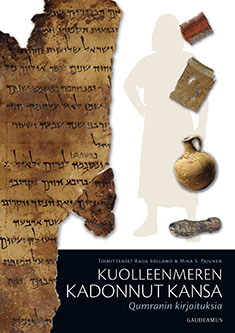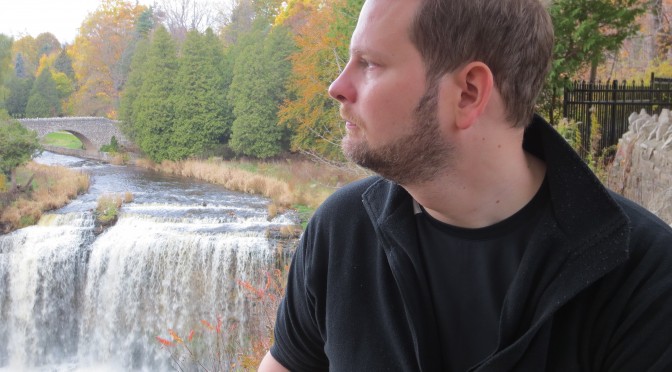(for a Finnish version of this interview, please click here)
The recently published Finnish translation of the Dead Sea Scrolls (Kuolleenmeren kadonnut kansa; Gaudeamus, 2015) opens a window into ancient Jewish literature and culture that was before the Qumran finds reachable only through the New Testament. The volume builds upon the work of internationally recognized Finnish Qumran scholars. It was edited by Raija Sollamo and Mika S. Pajunen, who also was recently granted the title of docent.
Pajunen works as a researcher in the Finnish Academy’s Centre of Excellence ”Changes in Sacred Texts and Traditions”, centered in the Faculty of Theology at the University of Helsinki. ”This translation volume is an important resource for those people who wish to study first hand sources of ancient Jewish society”, Pajunen describes. According to him, it is increasingly important to study the correlation between literary and societal changes. ”Societal changes almost inevitably result in the reinterpretation and adaptation of earlier traditions, in order for these traditions to stay meaningful in the new situation. The same mechanisms of change are also at play in modern societies. A profound understanding of such mechanisms is thus essential not only in order to understand religion but human culture in general.”

Lately the world has indeed seen huge changes on the global scale. In the midst of severe economic difficulties it is easy to forget the importance of extensive and critical understanding of history and culture. Docent level scholars in the field of Old Testament studies can play a major role in further illuminating this area of human life.
”The scholars who are granted the title of docent in Old Testament studies are multidisciplinary experts in (ancient) cultures and societies. They have solid expertise not only regarding the collection of texts known as the Old Testament/Hebrew Bible, Jewish culture and religion in general, but also in varying other sources and cultures such as the Septuagint, archaeology, the ancient Near East, the Hellenistic World, and Qumran texts. Old Testament Docents have a great deal to contribute also more broadly in the field of humanities, and this kind of interdisciplinary co-operation will hopefully increase markedly in the future.”
Diverse research with two particular perspectives
In his research, Pajunen utilizes two different perspectives. First, the important basic research consisting of detailed analysis of manuscripts and texts. Without this work, further research of the textual evidence is left without a proper basis in the evidence. In the Biblical Studies department at the University of Helsinki, Pajunen is well-known for his expertise in the material reconstruction of scrolls. ”The method is based on an analysis of both the physical characteristics of the manuscripts and the techniques and practices used by the scribes. In the best case scenario, this method allows us to put the extant separate fragments of a manuscript into their proper places in the original whole – much like when assembling a puzzle.”
The other perspective is mostly related to surveying wide trajectories. ”How have specific phenomena, traditions, and ideologies developed over time? Such research is naturally dependent on a detailed source analysis, and a wide knowledge of the preserved material.” A recent example of such an approach is Pajunen’s article The Praise of God and His Name as the Core of the Second Temple Liturgy, published in the journal Zeitschrift für die alttestamentliche Wissenschaft.
The list of primary sources used in Pajunen’s research is long. Behind every study lies the question of the social world from which different texts and traditions emerge. ”In my research, I have not focused on applying just one specific method. Instead, the varying research questions have guided the choice of the most appropriate and helpful methods for solving those questions. For the most part, I have studied psalm texts – both those that can now be found in modern canons and those that ended outside of them. I have particularly focused on the diverse functions and settings where psalms and prayers were used in the Second Temple period. In addition, I have written a few smaller studies dealing with aspects of wisdom literature, the Chronicles, and the collections of the Twelve ’Minor’ Prophets.”
At the moment, Pajunen is writing his next monograph which should be ready in the fall of 2016. It deals with a literary phenomenon of embedding long poetic passages in prose contexts that was used by authors and editors in the Second Temple period. The sources for this research consist of a wide array of texts from the present Hebrew Bible, New Testament, Apocrypha, and Qumran scrolls.
In addition, Pajunen has been invited to take part in the official re-editions that are being produced of some of the Dead Sea Scrolls. ”Some of the earliest official editions published in the Discoveries in the Judean Desert series do not meet the modern standards that most of the volumes in the series adhere to. Also, nowadays, scholars have better tools for studying manuscripts offered by recent advances in technology.” Pajunen is responsible for editing manuscripts for three volumes of the upcoming series published by Brill. These include editing manuscript 4Q185 that contains a wisdom admonition for the re-edition of DJD V and seven manuscripts containing psalms and prayers for the re-edition of DJD I. Most recently, he has also accepted an invitation to edit several manuscripts for the re-edition of DJD III. ”In this project, I am responsible for five manuscripts that contain psalms, curses, and parables. In addition to these tasks, I am editing, together with my colleague Jeremy Penner, a conference volume to the BZAW series on the functions of psalms and prayers in the Second Temple Period.
The international journey of the docent continues
The newly appointed docent has plenty of experience from working abroad. In addition to the regular conferences, he has worked as a visiting researcher in several universities around the world. Several places have made a particular impact on him. Especially Jerusalem and Israel-Palestine are memorable places. ”It is incredible how much fits into such a small region. The diversity of different cultures and religions is intertwined with the rich history and geographical differences. For a scholar of the Qumran texts, it is of course a special thrill to study the original scrolls at the IAA laboratory in Jerusalem, to walk on the shores of the Dead Sea, and to visit the ruins and caves of Qumran, as well as the fortress of Masada. There is also something unique and almost mystical in studying ancient Jewish texts while in a dominican monastery that is surrounded by minarets.”
Pajunen also remembers warmly other places in the world: the small German university cities of Heidelberg and Göttingen, the regions of Hamilton and Toronto in Canada with their fantastic nature and succesful mixture of people from different cultures, and Rome, Vienna, and Oxford with their splendid histories. ”Next on the agenda is a research stay at Manchester and lecturing trips from there to Dublin and Edinburgh.”
The title of docent represents an important stage in the career of Pajunen. ”I have always shared the opinion of my dissertation supervisor Raija Sollamo that one should carry on in the academic world at least until given the title of docent.” The application process for obtaining the title is very thorough and includes a strict evaluation of the applicants scientific merits and development as a teacher. ”Unlike when applying for a job, the evaluation is focused entirely on the development and merits of a particular applicant, not in a comparison and ranking of the achievements of a group of applicants.” However this important achievement is not the final dream for Pajunen in the academy, but an interim stage on a road that goes ever on and on.

